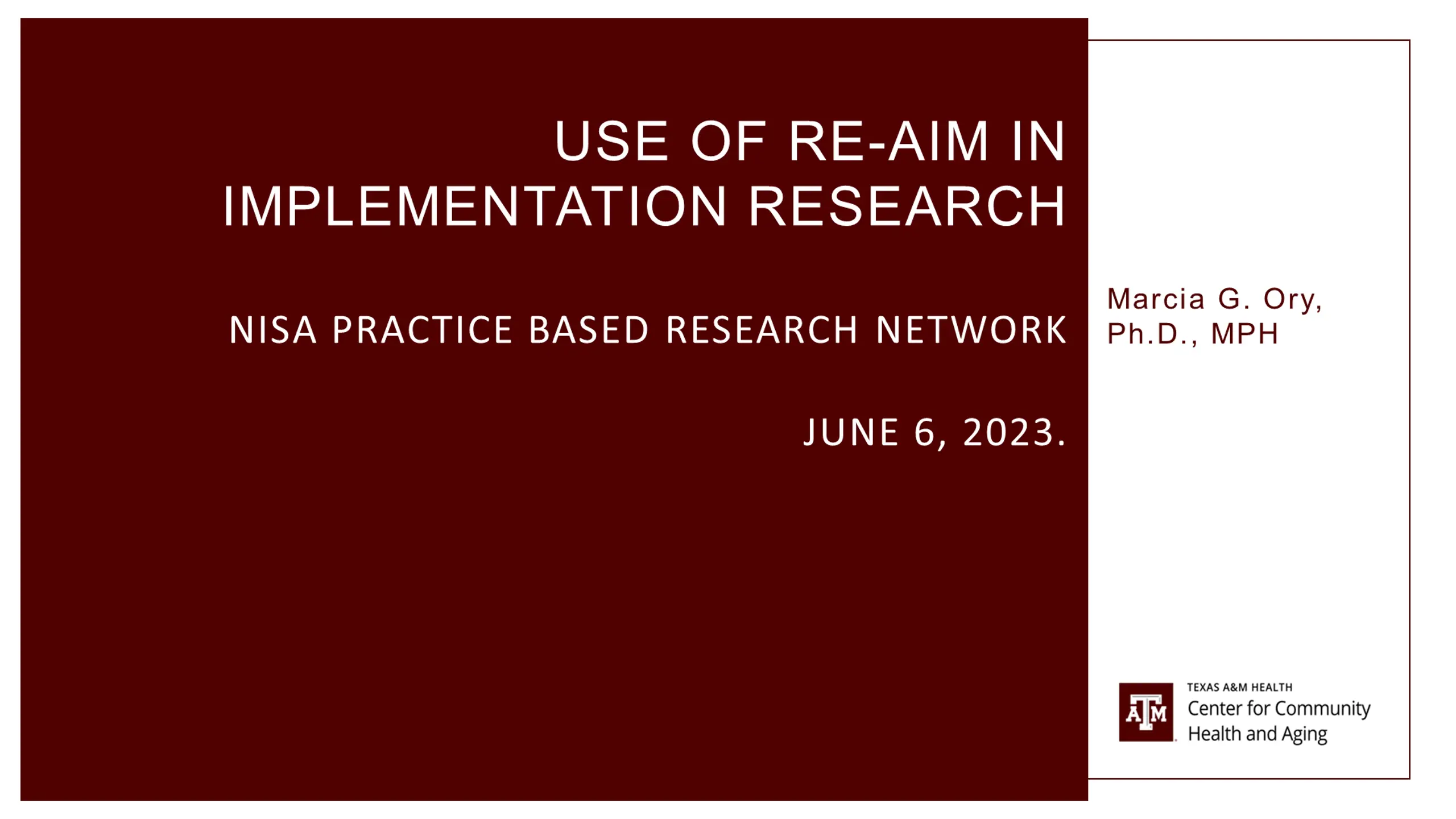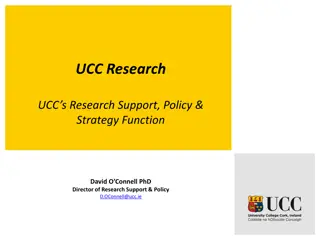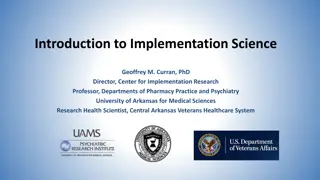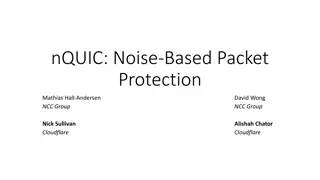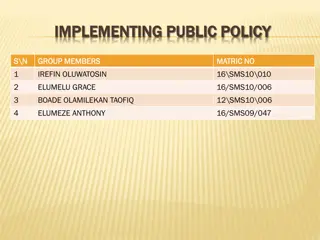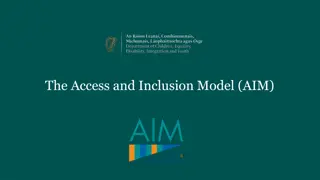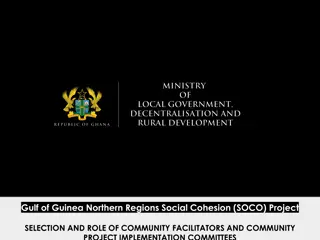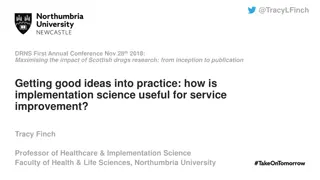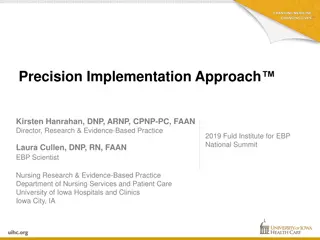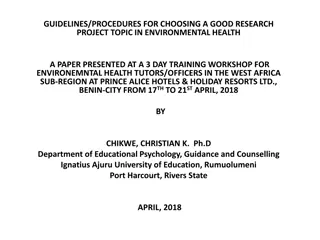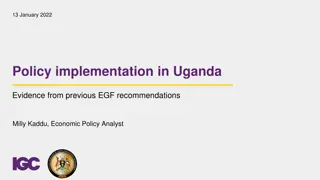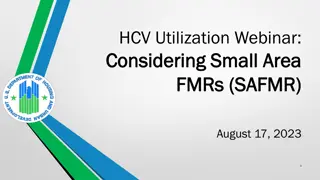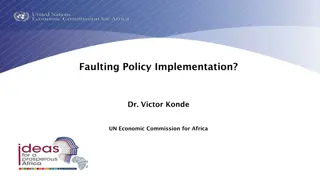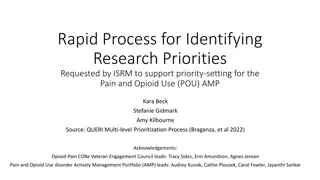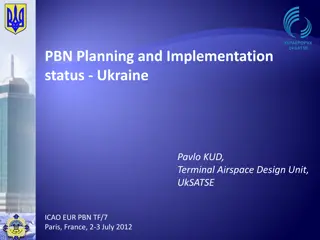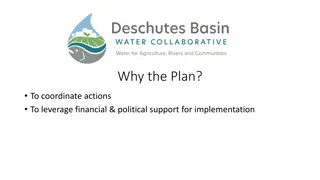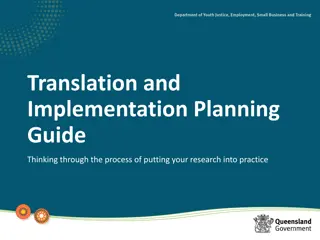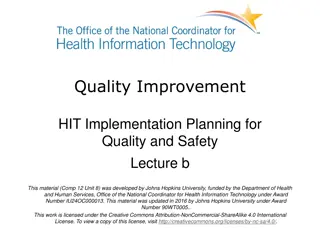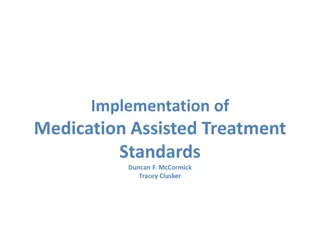Effective Use of RE-AIM in Implementation Research
Explore the origins, elements, and case uses of the RE-AIM framework. Learn how to address common misconceptions, its evolution, and related resources. Follow Dr. Marcia G. Ory's professional journey and the mission of the Center for Community Health and Aging. Discover the RE-AIM origin story, hypothetical interactions, and the research-to-practice gap highlighting challenges in evidence-based practices dissemination.
Download Presentation

Please find below an Image/Link to download the presentation.
The content on the website is provided AS IS for your information and personal use only. It may not be sold, licensed, or shared on other websites without obtaining consent from the author.If you encounter any issues during the download, it is possible that the publisher has removed the file from their server.
You are allowed to download the files provided on this website for personal or commercial use, subject to the condition that they are used lawfully. All files are the property of their respective owners.
The content on the website is provided AS IS for your information and personal use only. It may not be sold, licensed, or shared on other websites without obtaining consent from the author.
E N D
Presentation Transcript
USE OF RE-AIM IN IMPLEMENTATION RESEARCH Marcia G. Ory, Ph.D., MPH NISA PRACTICE BASED RESEARCH NETWORK JUNE 6, 2023.
TODAYS TOPICS Origin Story It s all about Context RE-AIM Elements Case Uses Common Misconceptions RE-AIM Evolution and related frameworks Resources
MY PROFESSIONAL JOURNEY Graduate Training (1971-1981) Social sciences & public health Life-course perspective National Institute on Aging (1981-2001) Research Discoveries Collaborative efforts Texas A&M School of Public Health (2001-) Aging and public health perspectives Research translation Center for Community Health and Aging Healthy aging/disease prevention as focal areas National Working Group on RE-AIM Planning and Evaluation Framework (www.re-aim-org).
CENTER FOR COMMUNITY HEALTH AND AGING Mission statement: To increase the capacity of individuals, organizations, and communities, to improve population health and aging well across the life-course utilizing a community health development approach and multi-level evidence-based solutions.
RE-AIM ORIGIN STORY: GLASGOW ET AL 1999 Lack of comprehensive evaluation framework for multilevel interventions Describe a new way of looking at public health impacts Reach, Effectiveness, Adoption, Implementation, and Maintenance Understand the interaction across different components Match interventions and measures to settings, goals, and purposes Discuss counter forces across different elements efficacious interventions may not be most translatable in real-world
HYPOTHETICAL INTERACTIONS ACROSS DIFFERENT COMPONENTS
RESEARCH TO PRACTICE GAP Only 18% of administrators and practitioners report using evidence-based practices frequently. It takes 17 years for research to reach practice. Only 14% of research reaches a target recipient. Balas EA, Boren, SA. Managing clinical knowledge for healthcare improvement. In Yearbook of Medical Informatics. 2000. Chagnon F, et al. Comparison of determinants of research knowledge utilization by practitioners and administrators in the field of child and fand family social services. Implementation Science. 2010:5:41.amily social services. Implementation Science. 2010:5:41.
CURRENT RESEARCH CHALLENGES Even if 100% effective, impact depends on: Traditional, highly- controlled RCTs versus real-world settings. (1) Adoption (2) Training (3) Fidelity (Implementation) (4) Access (Reach) (5) Sustainability (Maintenance) Voltage drop of effectiveness. 50% threshold for each step= .5*.5*.5*.5*.5= 3% benefit What is most relevant to the stakeholders? Rothwell PM. External validity of randomised controlled trials. Lancet 2005;365:82-93.
Dissemination: Information sharing Implementation: Intervention integration Pragmatic: Under usual conditions relevant to stakeholders AND rigorous. Illustration by Dave Cutler
D&I SCIENCE Theories Frameworks Models Tabak RG et al. Bridging Research and Practice: Models for Dissemination and Implementation Research Am J Prev Med, 2012, 43: 337 350.
CHOOSING A D&I MODEL Consider fit with: Key constructs of your project Levels of the socio-ecological framework D&I purpose (dissemination, implementation, or both) Content area and/or context of your project Pragmatic issues How long used Ease of use
RE-AIM Facilitate translation of research to practice. Balance internal and external validity. Address multi-level factors: individual, organizational, system: experimental and observational. Emphasize representativeness.
RE-AIM Intervention + Implementation Goals Adopted broadly. Sustained implementation at reasonable cost. Reaches large numbers of people. Replicable and long-lasting outcomes.
Technical Definition The absolute number, proportion, and representativeness of individuals willing to participate in a given initiative, and the reasons why (qualitative). Pragmatic Use WHO is intended to benefit and who actually participates or is exposed to the initiative? REACH Glasgow RE, Estabrooks PE. Pragmatic Applications of RE-AIM for Health Care... Prev Chronic Dis 2018;15:170271. DOI: http://dx.doi.org/10.5888/pcd15.17027
Technical Definition The impact of an initiative on outcomes, including potential negative effects, heterogeneity, quality of life, and economic outcomes as well as the reasons why (qualitative). Pragmatic Use WHAT is the most important benefit you are trying to achieve and what is the likelihood of negative EFFECTIVENESS outcomes? Glasgow RE, Estabrooks PE. Pragmatic Applications of RE-AIM for Health Care... Prev Chronic Dis 2018;15:170271. DOI: http://dx.doi.org/10.5888/pcd15.17027
Technical Definition The absolute number, proportion, and representativeness of settings and agents willing to initiate a program, and the reasons why (qualitative). Pragmatic Use WHERE is the program applied and WHO applied it? ADOPTION Glasgow RE, Estabrooks PE. Pragmatic Applications of RE-AIM for Health Care... Prev Chronic Dis 2018;15:170271. DOI: http://dx.doi.org/10.5888/pcd15.17027
Technical Definition Fidelity to the intervention protocol, and including adaptations, time, and cost as well as the reasons why (qualitative). Pragmatic Use HOW consistently was the program delivered, how was it adapted, how much did it cost, and WHY did the results come about? IMPLEMENTATION Glasgow RE, Estabrooks PE. Pragmatic Applications of RE-AIM for Health Care... Prev Chronic Dis 2018;15:170271. DOI: http://dx.doi.org/10.5888/pcd15.17027
Technical Definition The extent to which a program becomes institutionalized at the setting level or sustained at an individual level as well as the reasons why (qualitative). Pragmatic Use WHEN was the program operational and how long are the results sustained? MAINTENANCE Glasgow RE, Estabrooks PE. Pragmatic Applications of RE-AIM for Health Care... Prev Chronic Dis 2018;15:170271. DOI: http://dx.doi.org/10.5888/pcd15.17027
RE-AIM IN NATIONAL INITIATIVES Administration for Community Living (Administration on Aging) Centers for Disease Control National Institutes for Health Robert Wood Johnson Foundation
FROM VISION TO REALITY Drawing on experience with the dissemination and implementation of chronic disease self-management programs Common themes and frameworks across different public health issues whether programs, policies, practices
SUCCESSES IN DELIVERY AND OUTCOME OF CHRONIC DISEASE SELF-MANAGEMENT PROGRAMS Ory MG, Smith ML, Patton K, Lorig K, Zenker W, and Whitelaw N. Self- Management at the Tipping Point: Reaching 100,000 Americans with Evidence-Based Programs. J Am Geriatr Soc. 2013; 61(5):821-823. 500,000+ Ory MG, Ahn S, Jiang L, Smith ML, Whitelaw N, Ritter P, and Lorig K. Successes of a National Study of the Chronic Disease Self-Management Program: Meeting the Triple Aim of Health Care Reform. Med Care. 2013; 51 (11): 992-998. Ory MG, Ahn S, Towne SD, and Smith ML., Chronic Disease Self-Management Education: Program Success and Future Directions. In ML Malone (ed.) Geriatrics Models of Care: Bringing Best Practice to an Aging America, Springer International Publishing Switzerland. Forthcoming 2023+. 100,00 0
3 MS TO SUCCESS MOMENT Recognition of the prevalence and costs of chronic conditions Recognition of the power of EBPs Recognition of translational research MOVEMENT ACL NCOA as technical assistance arm Aging services network MOMENTUM Person-centered care Reimbursements for EBPs D&I science and practice
BUILDING THE EBP MOVEMENT CDSMP research studies 1999; 2001; 2013 Evidence-based Programmatic Demonstrations (2003) American Recovery and Reinvestment Act (2009) Evidence-based requirement for use of Title III-D funding (2012) Continued Support for widespread dissemination of EBPs through aging services network
HOW TO GET STARTED WITH EBPS No need to start from scratch Many different programs tested Growing inventory of evidence- based programs Rated on implementation and dissemination factors Training and technical assistance available https://www.ncoa.org/evidence-based-programs
EARLY D&I EFFORTS IN AGING SERVICES SECTOR NCOA highly encouraged use of RE-AIM Model in their grantee program Could the aging services sector successfully employ a D&I Model in the field? Highlights: Key stakeholders reported perceived utility However difficult to track all of the elements in the field
RECENT RE-AIM EXAMPLE Diabetes is a major problem in South Texas Can we deliver a culturally relevant practice-based DSME that will improve the health of underserved populations who often lack access to medical care? Who can make this happen Part of Healthy South Texas initiative Ory MG, Lee S, Towne SD, Jr., Flores S, Gabriel O, and Smith ML. Implementing a Diabetes Education Program to Reduce Health Disparities in South Texas: Application of the RE-AIM Framework for Planning and Evaluation. Int Journal Environ Res Public Health. 2020; 17 (17): 6312.
DIABETES EDUCATION PROGRAM (DEP) Reach Effectiveness Adoption Implementation Maintenance Adults with diabetes living in South Texas 2015-2019 ADA recognized 12-month program involving 8 hours of in- person workshop education followed by quarterly follow-up sessions Delivered by community-health workers and health educators
DEP ADAPTATIONS Re-envisioned as Making Moves with Diabetes Standardized and Manualized Shorter intervention time frame Both virtual and in-person versions Attention to getting and keeping participants in the program Outcomes even stronger .. It is critical to understand what works and what doesn t and adapt implementation strategies while adhering to essential intervention strategies
NEWEST EXPLORATION: FROM COMPENSATORY ACTIONS TO NEXT GENERATION INTERVENTIONS* Live in Control Adapted from two evidence-based diabetes self-management training programs Key adaptations Shortened intervention period Culturally sensitive for minority populations Family-oriented support Lay-led Set within a 3-C context
MAPPING STRATEGIES TO RE-AIM OUTCOMES: MORE THAN EVALUATION
UNDERSTANDING THE HOW AND WHY OF INTERVENTION EFFECTS
HOW HAS RE-AIM EVOLVED OVER 20 + YEARS 700+ articles 2,400+ citations New content Patient- centered outcomes research Costs and resources Adaptations areas . Glasgow, RE, et al. Front Public Health. 2020;7, 64. Holtrop et al. BMC Health Serv Res. 2018 Mar 13;18(1):177. Gaglio et al. The RE-AIM Framework AJPH. 2013;103:38-46
EVOLUTION OF RE-AIM: MORE COMPLEXITY AND CREATIVITY
EVOLUTION OF RE-AIM MERGING OF D&I MODELS Combining RE-AIM with other models, especially Pragmatic, Robust, Implementation and Sustainability (PRISM) Model- to assess relevant contextual factors
RE-AIM EXAMINING HEALTH EQUITY ISSUES RE-AIM Issue Disparity Overall Impact Reach 30% 70% benefit Effectiveness 0 (equal) 70% benefit Adoption 30% 49% benefit Implementation 30% 34% benefit Maintenance 30% 24% benefit Take Home Message: Equity issues at EACH STAGE of RE-AIM
KEY DISPARITY ISSUES BY RE-AIM DIMENSIONS Re-AIM Element Reach Key Disparities Issues* Accessing disparate populations through targeted outreach methods and program options Understanding characteristics of those who participated vs. those who declined Effectiveness Assessing broader, patient-centered outcomes, quality of life, and unanticipated consequences Understanding the impact of the context on results Analyzing results by disparity-related subgroups consider disparities broadly Documenting and enhancing participation of low-resource settings and a variety of staff Understanding and addressing reasons for non-participation by setting/staff Adoption Implementation Monitoring delivery to different subgroups and by different staff Understanding and tracking costs of delivery Transparently documenting adaptations to original program Maintenance Assessing long-term results across subgroups and identifying inequities and reason Providing infrastructure and links to community resources for individuals to sustain program results Planning for and supporting sustainability of program after initial evaluation Preparing delivery settings with tools to guide monitoring and adaption of the program long term * Glasgow RE, et al. Use of RE-AIM to Address Health Inequities: Application in a low-income community health center based weight loss and hypertension self-management program. Transl Behav Med. 2013 Jun 1;3(2):200-210.
FOR IMP Logic Model for Implementation Research* *https://static1.squarespace.com/static/551c1b44e4b002dbe1feee84/t/5f74cc6ae733a60563e713f0/1601490076335/PSMG+2020+IRLM+FINAL.pdf
EVOLUTION: LESSONS LEARNED
RE-AIM USE TIPS Select a D&I framework that matches the study purpose, setting, and population Consider combining different frameworks, as needed Apply chosen framework throughout your research/proposal Document adaptations before, during, and after implementation Chose pragmatic D&I assessment measures Plan sustainability upfront with the end-in-mind https://dissemination-implementation.org/tool/; https://implementationscience.biomedcentral.com/articles/10.1186/1748-5908-7-96 https://www.youtube.com/watch?v=W3r7HEAXJHg https://www.ncbi.nlm.nih.gov/pmc/articles/PMC9260852/
Glasgow RE, Vogt TM, Boles SM. Evaluating the public health impactthe RE-AIM framework. Am J Public Health. 1999 Sep;89(9):1322-7. Estabrooks PA, Glasgow RE. Translating effective clinic-based physical activity... Am J Prev Med. (2006) 31 (4 Suppl.):S45 56. doi: 10.1016/j.amepre.2006.06.019 Shoup JA, et al. Network analysis of REAIM framework. Transl Behav Med. (2015) 5:216 32. doi: 10.1007/s13142-014-0300-1 Ory MG, et al. Perceived utility of the RE-AIM framework for older adults... Front Public Health. (2015) 2:143. doi: 10.3389/fpubh.2014.00143 Gaglio B, Shoup JA, Glasgow RE. The RE-AIM framework: a systematic review of use over time. Am J Public Health. (2013) 103:e38 46.doi: 10.2105/AJPH.2013.301299 Harden, et al. Fidelity to and comparative results across behavioral interventions : a systematic review. Syst Rev. (2015) 4:155. doi: 10.1186/s13643-015-0141-0 Glasgow RE, Estabrooks PE. Pragmatic Applications of RE-AIM for Health Care... Prev Chronic Dis 2018;15:170271. DOI: http://dx.doi.org/10.5888/pcd15.170271 Glasgow, RE, et al. (2019). RE-AIM Planning and Evaluation Framework: 20-Year Review. Front Public Health, 7, 64. doi:10.3389/fpubh.2019.00064 Key RE-AIM References Special issue on RE-AIM in Frontiers of Public Health in 2020: Contains >13 articles.
FAQs Guidance on application Searchable list of 700+ article abstracts. Calculators, checklists, tools. Webinars, upcoming events, blogs. Additional Resources at www.re-aim.org
CONTACT US ccha.tamu.edu mory@tamu.edu https://re-aim.org/
